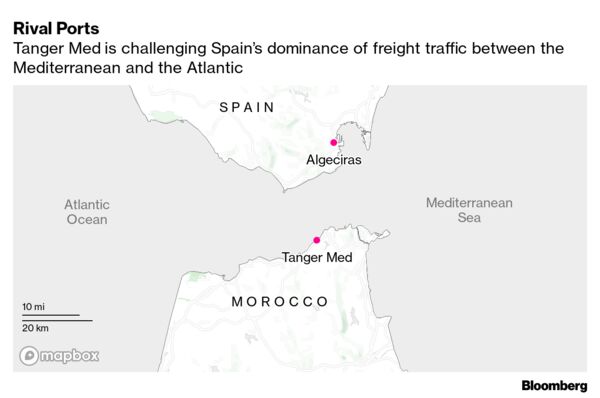Spanish ports have in recent years dominated the freight traffic between the Mediterranean Sea and the Atlantic, but a thriving Moroccan rival is now jeopardizing that hegemony.
Located just across the Straight of Gibraltar, Tanger Med handled almost 5.8 million TEUs (20-foot equivalent units) last year, a more than 20% jump over 2019, making it the area’s busiest container port. It outpaced its most direct competitor, Spain’s Algeciras, whose freight traffic in the same period decreased 0.4% to about 5.1 million TEUS.
A bustling hinterland — the inland region surrounding a port — combined with cheaper labor costs and an increasingly high-quality road transportation network have contributed to underpin the consolidation of the Moroccan hub, according to Jordi Espin, policy manager at the European Shippers’ Council.
Maersk, CMA-CGM and Hapag-Lloyd are listed among the biggest carriers to call on the Moroccan port.
“Ten years ago Tanger Med wasn’t regarded as a big competitor. But it has been growing in the meantime, it has hired top professionals with an international education, and now has a very, very clear business plan,” Espin said in an interview. “While Spain has stricter laws that have to be negotiated with social agents, especially when it comes to stowage, Tanger Med can count on a tailored legislation aimed at making it as modern and competitive as possible.”

A short ferry ride from Tanger Med is the Spanish city of Algeciras, among the country’s busiest ports alongside Barcelona and Valencia. Algeciras’s specific focus on trans-shipment has allowed it to integrate its activities with the rest of the national port network and offset the lack of a competitive hinterland, but it may end up hindering its transformation into a more conventional hub, Espin said.
Recent global trade trends linked to the coronavirus pandemic are also playing a role in the growth of the Moroccan port. A steep, e-commerce-driven increase in the demand of goods coming from Asia have prompted the deployment of large carriers that need the infrastructure of a modern terminal such as Tanger Med, Espin said.
“The big question mark is whether this could be beneficial also for Algeciras,” he said.
—Thomas Gualtieri in Madrid
Charted Territory

The impact of Britain’s departure from the European Union’s single market isn’t letting up after five weeks of the new trade deal. High-frequency data show that freight volumes from the U.K. to the EU were down by about 25% from year-ago levels last week because of Brexit red tape and the impact of the coronavirus, according to the logistics platform Transporeon.
Today’s Must Reads
- Squeeze box | Cargo shippers may see some rate relief around midyear as bottlenecks at ports caused by the pandemic ease and companies add more containers. Meanwhile, the world’s largest carrier said freight rates are close to peaking, an outlook that disappointed Maersk investors.
- Under wraps | The U.K. government won’t publish an impact assessment of its trade accord with the EU despite producing similar reviews of other major trade deals it has signed. Meanwhile, JD Sports will open a new distribution warehouse in the EU to cope with the worse-than-expected impact of Brexit red tape and tariff costs.
- Money supply | Lex Greensill rose from working on his family’s melon and sugar cane farm in Australia to roaming the skies in a private jet. His ascent to the top of the supply-chain finance industry has been far from smooth.
- New deals | A key House Democrat said he’s hopeful that talks for free-trade deals with the U.K. and Kenya can be completed this year even as President Joe Biden focuses on enforcement of existing agreements with the U.S.’s biggest partners.
- Eye on lithium | The Biden administration’s first test of its climate change policy could come this week in a legal dispute over battery components seen as key to expanding electric vehicle adoption in the U.S.
- Solar flare | A global shortage of semiconductors critical to auto and electronics makers has also ensnared the solar sector, with Enphase Energy saying it experienced constraints in the global chip supply chain last quarter. U.S. automakers, meanwhile, are expanding production cuts in North America.
- Fish fight | New Zealand said it is urgently seeking clarification from Chinese authorities after Beijing suspended imports from two of its seafood factories.
On the Bloomberg Terminal
- Turning tide | Global container rates’ robust momentum could linger, with Bloomberg Intelligence expecting rates to normalize in 2H amid vaccine rollouts and a gradual shift back towards services activity.
- Best yet | New Zealand recorded its largest calendar-year surplus on record in 2020 as imports slumped and lower crude-oil prices reduced the import bill, Bloomberg Intelligence says.
- Use the AHOY function to track global commodities trade flows.
- Click HERE for automated stories about supply chains.
- See BNEF for BloombergNEF’s analysis of clean energy, advanced transport, digital industry, innovative materials, and commodities.
- Click VRUS on the terminal for news and data on the coronavirus and here for maps and charts.
Like Supply Lines?
Don’t keep it to yourself. Colleagues and friends can sign up here. We also publish Balance of Power, a daily briefing on the latest in global politics.
For even more: Follow @economics on Twitter and subscribe to Bloomberg.com for unlimited access to trusted, data-driven journalism and gain expert analysis from exclusive subscriber-only newsletters.
How are we doing? We want to hear what you think about this newsletter. Let our trade tsar know.
— With assistance by Rodrigo Orihuela







